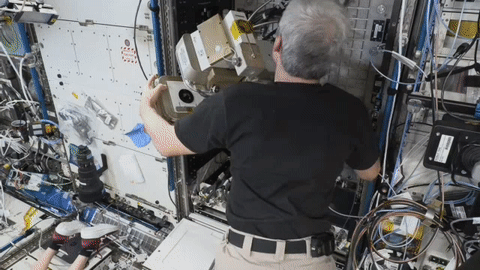Editor’s Note: The SpaceX Cargo Dragon undock date was updated to Saturday, Jan. 22.
A retired microscope and samples from studies on colloids and cellular signaling are among the cargo returning from the International Space Station aboard the 24th SpaceX commercial resupply services mission. The Dragon craft, which arrived at the station Dec. 22, 2021, is scheduled to undock Jan. 22 with splashdown the next afternoon off the coast of Florida.
These quick return flights allow scientists to make additional observations and analyses of their experiments at Kennedy Space Center, minimizing the effects of gravity on samples. Investigators then can conduct more in-depth analyses back at their home labs.
Read more about some of the equipment and experiment samples making the journey back to Earth:
Last light for LMM
A state-of-the-art light imaging microscope, the Light Microscopy Module (LMM), launched to station in 2009 and returns to Earth aboard Dragon for a well-earned retirement. Sponsored by NASA’s Biological and Physical Sciences division, this powerful diagnostic tool enabled novel research of microscopic phenomena in microgravity, providing the capability to remotely acquire and download images and videos at many levels of magnification.
LMM made it possible to observe and record the way matter is organized and moves on the microscopic level. Scientists employed this tool for microgravity research on colloids, tiny particles suspended in a liquid, that contributed to advances in formulations and the shelf life of consumer products such as toothpaste and shampoo, 3D printing, and technology for detecting shifting sands on Mars. The LMM also contributed to studies of plants in microgravity, including the CARA investigation, and supported thermophysics research, including CVB and CVB-2, studies on heat transfer systems in microgravity.
Tiny structures, assemble
InSPACE-4 studies assembly of tiny structures from colloids, or particles suspended in a liquid, using magnetic fields. Colloidal structures change the properties of the assembled material, such as its mechanical response to or interaction with light and heat. Microgravity offers a unique opportunity to observe assembly in ways and over time scales not possible on Earth.
Results could provide insight into how to harness nanoparticles to fabricate and manufacture new materials and lead to more advanced materials for space applications, including thermal shields, protection from micrometeorites, energy production, energy-transfer, and actuators and sensors for robotic and human missions. Other potential applications include advancing the manufacturing of materials on Earth for applications such as thermal shields, sound damping devices, camouflage, and medical diagnostics. The technology also could support larger-scale applications such as building foundation stabilizers for areas prone to earthquakes.
Investigators monitored the experiment via video downlink and vials containing the colloidal structures are returning to Earth for additional analysis.
Cell signaling in microgravity
Scientists continue to study how microgravity affects mammalian cells. Cytoskeleton, an investigation from ESA (European Space Agency), examines whether microgravity affects the function of cellular signaling molecules known as RhoGTPases. These molecules function as “molecular switches” and are involved in the control of cell proliferation, programmed cell death, gene expression, and organization of the cytoskeleton (the network of protein filaments and tubules that give cells their shape).
This investigation contributes to our understanding of how the human body responds to microgravity and could support development of countermeasures to help crew members maintain optimum health on future missions. The work also may expand knowledge about cellular function on Earth and contribute to future medical research here on the ground. Cell cultures are returning to the ground for analysis.
Live coverage of the departure begins on Saturday, Jan. 22. at 10:15 a.m. EST on NASA Television, the agency’s website, and the NASA app. Find updates on undocking, splashdown, and subsequent events on the space station blog.
For daily updates, follow @ISS_Research, Space Station Research and Technology News, or our Facebook. For opportunities to see the space station pass over your town, check out Spot the Station.
Melissa Gaskill
International Space Station Program Research Office
Johnson Space Center




























